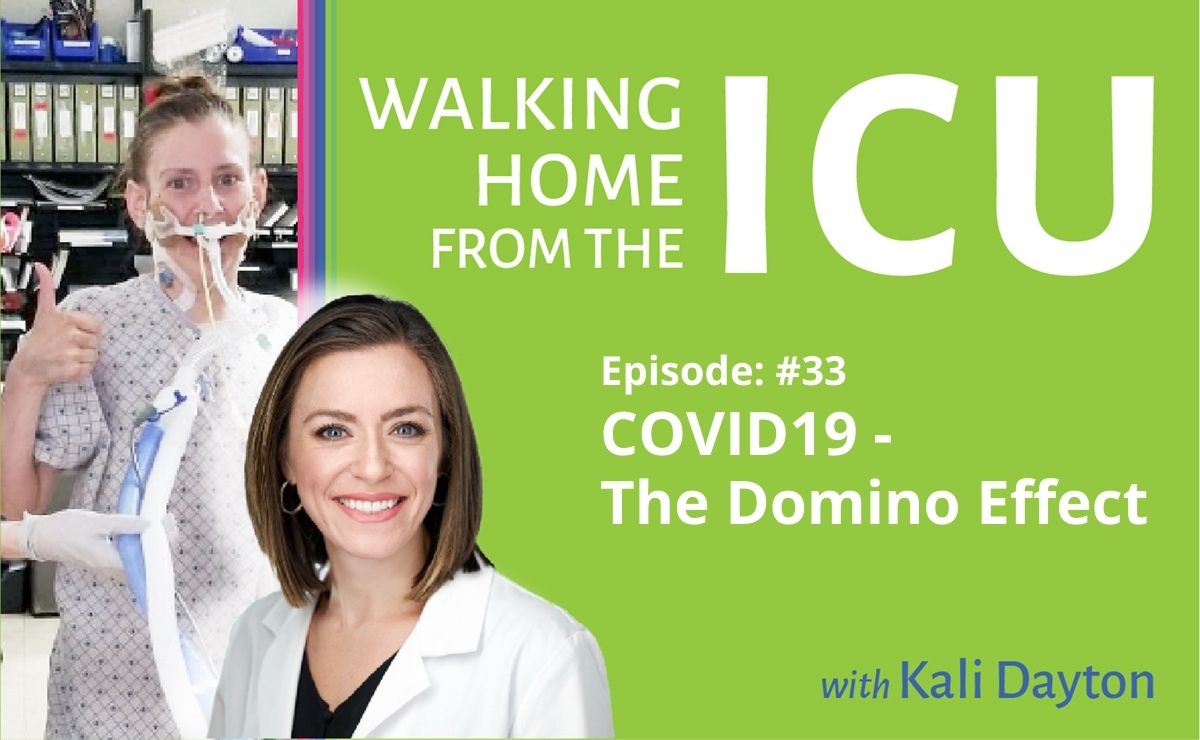SUBSCRIBE TO THE PODCAST
Kali talks about what can we do to improve mortality in the midst of a pandemic and how, as times have changed, our practices must change as well.
Episode Transcription
Kali Dayton
Hello, and welcome back. A lot has been happening in our ICU world. Over the past few weeks, I feel compelled to talk about some things…. and I hope that makes sense.
If you haven’t listened to this podcast yet, go back and listen to it after this episode. Episodes 1, 5, 9, 11, 14, 21, and 23 through 25 especially focus on what is going on right now. This episode will make a lot more sense after listening to those and the rest of the podcast.
This podcast thus far has been a thorough explanation and above all else, a plight to change our ICU practices for patients on ventilators. We have discussed postICU PTSD, cognitive deficits, ICU acquired weakness, all in the light of preventing further suffering and harm to patients and helping them return back to their lives.
I stand by all that has been shared by survivors, family members, researchers and my colleagues. On a personal note, I never aspired or wanted to do a podcast. A few months ago, I had the distinct revelation to do this, and felt inexplicably called to reach out to the ICU community in this way. With those feelings, came an overwhelming sense of urgency.
I couldn’t explain it, but I couldn’t deny it either. So I whipped out those 32 episodes in less than two months, only because of that inner urgency- not knowing what was going to happen to our world. Now we stand at the shore, waiting for the tsunami of COVID-19 to crash over us. And I have realized that these changes spoken of in the podcast need to come now.
We have preached sedation cessation and mobility in the name of compassion. I wish that would have been enough for us in the years past. Some of you may be saying “Seriously, you want to talk about cessation of sedation and mobility now? We can only to focus on life or death right now.”
You are so right. This is precisely why I am bringing it up again. We now have to approach this immediately if for nothing else, but for dire necessity. If we can anticipate anything by what we have witnessed in China, Italy and Iran, it is that we will not have enough ventilators beds, personal protective equipment, staff or other equipment to care for the masses of COVID-19 patients in respiratory failure.
With such realistic concerns, I add to those as our ICU culture has stood. Patients are still being deeply sedated the second they are intubated. We know that sedation causes prolonged delirium, we know that it prevents the opportunity to keep these patients moving and strong and that increases length of stay, death rates, cognitive deficit, post ICU, PTSD, etc. So let’s talk about this in the context of COVID-19.
The recommendations that have been made are to intubate anyone that requires more than six liters nasal cannula. It is safer for staff exposure, and I get it so let’s do it. The concern is that now if we intubate people sooner, then our teams will sedate them even sooner in their course of illness. This means that they will not be moving a muscle for likely even longer than what had been standard before. Many of these patients will develop ARDS in some severe ARDS.
If we are sedating them and leaving them to decondition in bed with minimal ventilator settings. We are depriving them of the opportunity to stay mentally and physically strong prior to pronation. After weeks of this, we all know there is no way they are going to be getting out of bed for a long time. We will have then caused ventilator dependence just from deconditioning. Once the infection is resolved and the lungs are healed, they will be too weak to hold their own heads up, protect their airway and breathe on their own.
Now is especially not the time to put brains and bodies on the sidelines while we focus on the lungs- to be pragmatic about it. This will unnecessarily occupy a ventilator that needs to go to someone else that is acutely ill. This may contribute to more mortality for the new patient showing up without a ventilator available, and for the patients that have survived COVID 19 and ARDS, but still faces high risks of mortality due to complications from deconditioning.
So what will we do with them? In the past, we were able to ship them out to LTACH to spend months on the ventilators trying to get them back on their feet again, and breathing on their own. Hopefully it is different in your city, but our LTACHs have been stressed and maxed to capacity for a long time. They are not prepared or equipped to handle the masses of severely deconditioned ICU survivors flowing in all at once.
As an ICU community, we have begged the public to take precautions and make changes to ease our burden of taking on more patients than we can handle. We must do the same for our patients and for the rehabilitation side of our system, even at our stress and panic. Now is the pivotal time to step back and see the big picture. We must change now to do everything possible to keep patients strong, so they can get better quicker, be extubated faster and walk out of our ICUs leaving beds, ventilators and staff available for the line of victims of this terrible disease.
We are in a whirlwind of changes. I don’t know how it will all work. PPE is a serious concern, staffing ratios, equipment, all of it seems insurmountable. I do not suggest these things in ignorance of the challenges we face. I am begging for these changes because of those challenges. If you were listening, please join in on the conversation.
What are your plans? What ideas have your teams formulated for this? How are you utilizing your physical therapist occupational therapist and nurses and the whole team to keep these patients awake and moving? Let’s collaborate together to figure this out. If we continue to deeply sedate and immobilize our patients on ventilators, we will cause more work overload, resource stress and mortality unless we change. We must not make our patients comatose and immobile. We have to keep them on their feet and strong as long and as much as possible.
We are being forced to do things we have never done before. May this be one of those things, if not for compassion as before, but now out of absolute necessity.
Transcribed by https://otter.ai
SUBSCRIBE TO THE PODCAST



 When patients are so ill that they require a ventilator in the ICU, the antiquated approach of heavy sedation and immobilization should be avoided in order to help prevent the immense burden of physical and cognitive disabilities suffered during survival. To understand this better, listen to Walking Home From The ICU. You will see what ICU consultant Kali Dayton provides to your team.
When patients are so ill that they require a ventilator in the ICU, the antiquated approach of heavy sedation and immobilization should be avoided in order to help prevent the immense burden of physical and cognitive disabilities suffered during survival. To understand this better, listen to Walking Home From The ICU. You will see what ICU consultant Kali Dayton provides to your team.
